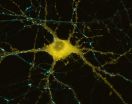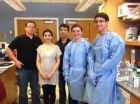(Press-News.org) MANHATTAN, KANSAS — Kansas State University diagnosticians are helping the cattle industry save millions of dollars each year by developing earlier and accurate detection of E. coli.
Lance Noll, master's student in veterinary biomedical science, Greensburg; T.G. Nagaraja, university distinguished professor of diagnostic medicine and pathobiology; and Jianfa Bai, assistant professor in the Kansas State Veterinary Diagnostic Laboratory, are leading a project to improve techniques for detecting pathogenic Shiga toxin-producing E. coli O157:H7. A U.S. Department of Agriculture Coordinated Agriculture Project grant is funding the work.
The researchers are part of a College of Veterinary Medicine team studying preharvest food safety in beef cattle. Noll has developed and validated a molecular assay that can detect and quantify major genes specific for E. coli O157.
"Developing a method to detect E. coli before it can potentially contaminate the food supply benefits the beef industry by preventing costly recalls but also benefits the consumer by ensuring the safety of the beef supply," Noll said.
The newly developed test is a molecular assay, or polymerase chain reaction, that detects bacteria based on genetic sequences, which are the bacteria's "fingerprints," Nagaraja said. The test is rapid and less labor-intensive than existing detection methods. The method can be automated and test many samples in a short period of time.
The test can be used in a diagnostic or research laboratory to accurately detect E. coli and can help with quality control in cattle facilities.
"The novelty of this test is that it targets four genes," Nagaraja said. "We are constantly working on finding better and more sensitive ways to detect these pathogens of E. coli in cattle feces."
To develop the diagnostic test, Noll and Nagaraja worked with two Kansas State University molecular biologists: Xiaorong Shi, research assistant of diagnostic medicine and pathobiology, and Bai.
"Beef cattle production is a major industry in Kansas and Kansas State University has a rich tradition in the research of beef cattle production and beef safety," Noll said. "As a graduate student in veterinary biomedical sciences, I am proud to be a member of a multidisciplinary team in the College of Veterinary Medicine that aims to make beef a safe product for the consumers."
Noll was a winner at the 11th annual Capitol Graduate Research Summit for his research project and poster, "A four-plex real-time PCR assay for the detection and quantification of Escherichia coli O157 in cattle feces."
INFORMATION:
Researchers create better methods to detect E. coli
2014-06-16
ELSE PRESS RELEASES FROM THIS DATE:
Getting rid of old mitochondria
2014-06-16
It's broadly assumed that cells degrade and recycle their own old or damaged organelles, but researchers at University of California, San Diego School of Medicine, The Johns Hopkins University School of Medicine and Kennedy Krieger Institute have discovered that some neurons transfer unwanted mitochondria – the tiny power plants inside cells – to supporting glial cells called astrocytes for disposal.
The findings, published in the June 17 online Early Edition of PNAS, suggest some basic biology may need revising, but they also have potential implications for improving ...
Discovery of Earth's northernmost perennial spring
2014-06-16
Boulder, Colo., USA – A Canadian team lead by Stephen Grasby reports the discovery of the highest latitude perennial spring known in the world. This high-volume spring demonstrates that deep groundwater circulation through the cryosphere occurs, and can form gullies in a region of extreme low temperatures and with morphology remarkably similar to those on Mars. The 2009 discovery raises many new questions because it remains uncertain how such a high-volume spring can originate in a polar desert environment.
Grasby and colleagues encountered the northernmost perennial ...
Pathological gambling runs in families
2014-06-16
A study by University of Iowa researchers confirms that pathological gambling runs in families and shows that first-degree relatives of pathological gamblers are eight times more likely to develop this problem in their lifetime than relatives of people without pathological gambling.
"Our work clearly shows that pathological gambling runs in families at a rate higher than for many other behavioral and psychiatric disorders," says Donald W. Black, MD, professor of psychiatry in the UI Carver College of Medicine. "I think clinicians and health care providers should be alerted ...
Low dose of targeted drug might improve cancer-killing virus therapy
2014-06-16
COLUMBUS, Ohio – Giving low doses of a particular targeted agent with a cancer-killing virus might improve the effectiveness of the virus as a treatment for cancer, according to a study led by researchers at The Ohio State University Comprehensive Cancer Center – Arthur G. James Cancer Hospital and Richard J. Solove Research Institute (OSUCCC – James).
Viruses that are designed to kill cancer cells – oncolytic viruses – have shown promise in clinical trials for the treatment of brain cancer and other solid tumors. This cell and animal study suggests that combining low ...
How our brains store recent memories, cell by single cell
2014-06-16
Confirming what neurocomputational theorists have long suspected, researchers at the Dignity Health Barrow Neurological Institute in Phoenix, Ariz. and University of California, San Diego School of Medicine report that the human brain locks down episodic memories in the hippocampus, committing each recollection to a distinct, distributed fraction of individual cells.
The findings, published in the June 16 Early Edition of PNAS, further illuminate the neural basis of human memory and may, ultimately, shed light on new treatments for diseases and conditions that adversely ...
Omega (ω)-3 inhibits blood vessel growth in a model of age-related macular degeneration in vivo
2014-06-16
Boston (June 16, 2014) – Age-related macular degeneration (AMD), which is characterized by choroidal neovascularization (CNV), or blood vessel growth, is the primary cause of blindness in elderly individuals of industrialized countries. The prevalence of the disease is projected to increase 50% by the year 2020. There is an urgent need for new pharmacological interventions for the treatment and prevention of AMD.
Researchers from Massachusetts Eye and Ear/Schepens Eye Research Institute, Harvard Medical School and other institutions have demonstrated for the first time ...
Caterpillars that eat multiple plant species are more susceptible to hungry birds
2014-06-16
Irvine, Calif. — For caterpillars, having a well-rounded diet can be fraught with peril.
UC Irvine and Wesleyan University biologists have learned that caterpillars that feed on one or two plant species are better able to hide from predatory birds than caterpillars that consume a wide variety of plants.
This is probably because the color patterns and hiding behaviors of the caterpillar "specialists" have evolved to allow them to blend into the background flora more effectively than caterpillars that eat many different plant species. Moving among these diverse plant ...
Hunt for extraterrestrial life gets massive methane boost
2014-06-16
A powerful new model to detect life on planets outside of our solar system, more accurately than ever before, has been developed by UCL (University College London) researchers.
The new model focuses on methane, the simplest organic molecule, widely acknowledged to be a sign of potential life.
Researchers from UCL and the University of New South Wales have developed a new spectrum for 'hot' methane which can be used to detect the molecule at temperatures above that of Earth, up to 1,500K/1220°C – something which was not possible before.
To find out what remote planets ...
Physician anesthesiologists identify 5 tests and procedures to avoid
2014-06-16
Proving that less really is more, five specific tests or procedures commonly performed in anesthesiology that may not be necessary and, in some cases should be avoided, will be published online June 16 in JAMA Internal Medicine. The "Top-five" list was created by the American Society of Anesthesiologists® (ASA®) for inclusion in the ABIM Foundation's Choosing Wisely® campaign.
"The Top-five list of activities to question in anesthesiology was developed in an effort to reduce unnecessary, costly procedures and improve patient care," said Onyi Onuoha, M.D., M.P.H., lead ...
Your genes affect your betting behavior
2014-06-16
Investors and gamblers take note: your betting decisions and strategy are determined, in part, by your genes.
University of California, Berkeley, and University of Illinois at Urbana-Champaign (UIUC) researchers have shown that betting decisions in a simple competitive game are influenced by the specific variants of dopamine-regulating genes in a person's brain.
Dopamine is a neurotransmitter – a chemical released by brain cells to signal other brain cells – that is a key part of the brain's reward and pleasure-seeking system. Dopamine deficiency leads to Parkinson's ...







